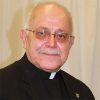What image comes to mind when you hear the word “missionary”? A knock at the door and two well-dressed strangers asking if you are saved? Bible tracts on the street corner, calling you to accept Jesus as your personal Lord and Savior?
Fairly or not, “missionary” is also historically fraught with dramatic images: Christian zealots breaking idols, overturning pagan altars and imposing baptism on conquered people. Missionaries often preceded or accompanied foreign colonizers. Since the time of Constantine, missionaries were as much identified with their imperial sponsors as they were with the Kingdom of God.
France, Spain and Portugal sent missionaries into newly discovered territories to cultivate allies as well as converts. The first martyrs of North America, St. Isaac Jogues, St. René Goupil and St. Jean de la Lande, were French Jesuits. France was allied with the Huron, enemies of the Mohawk, who were allied with the English (rivals of the French). Thus, the animosities of Europe translated into the inter-tribal rivalries of the New World. The Mohawk martyred the Jesuit missionaries as much for being French as for being Catholic.
Missionaries have rightly been criticized for mistreating Native Americans, or at least, aiding colonizers. But what about Servant of God Bartolomé de las Casas? A landowner-turned-Dominican missionary to Central America, Las Casas spent 50 years of his life advocating for the dignity of indigenous peoples, while European theologians debated whether native people had souls. And many Jesuit missionaries died in Paraguay defending the Guaraní population from Spanish slave traders.
Our co-founder Bishop James A. Walsh intentionally referred to his spiritual sons as “missioners” to distinguish them from “missionaries.” The distinction is more than semantic. Decades before the word “inculturation” was coined, Maryknoll missioners were trained to respect the traditions and religions of the people they served. Foreshadowing the Vatican II document Nostra Aetate, Maryknollers “reject nothing that is good and holy in these religions.” Churches built by Maryknollers in China and Korea, for example, reflect an unmistakable Oriental style, as does Maryknoll’s iconic headquarters in Ossining, New York.
Maryknoll missioners ascribe to the “job description” of St. Teresa of Calcutta: “I give people an experience of God; after that, it’s up to them how they choose to worship.” This spirit is seen in the ministry of Father James Kroeger, who promotes understanding between Christians and Muslims in the Philippines. Similarly in Bangladesh, Father Robert McCahill, the only Christian for miles around, lives and works among Muslims in what he describes as the “dialogue of life.” Brother John Beeching has immersed himself in the Buddhist spirituality of Thailand and Myanmar, insisting that doing so deepens his appreciation for Christianity. Mission, he says, means “falling in love with the world because you’ve fallen in love with God.”
Perhaps the greatest distinction between a missionary and a missioner is the difference between proselytizing and evangelizing.
Proselytizing means viewing others as objects to be converted to Catholicism through baptism, whether or not they encounter the reality of Christ in their lives. For centuries missionaries were motivated by an urgency to save souls. Conversion in this context meant a change of religion but not necessarily a change of heart.
Evangelization recognizes and respects others as partners on the journey, who are invited into the Reign of God as defined and inaugurated by the teachings, life, death and resurrection of Jesus Christ. It means walking, working, living and sometimes dying with them as they encounter Christ in their culture as well as in the Church.
Methods of mission have changed over the millennia, but the message remains the same: God’s love and grace are for all people! Missioners still proclaim this Good News.
Church on the way: Pope Francis’ message says, “The specific vocation of the Church is evangelization, which isn’t proselytism, no. Its vocation is evangelization; even more, the Church’s identity is evangelization.” (Video by the Pope’s Worldwide Prayer Network)
Featured image: Maryknoll Father Robert McCahill, who ministers to the sick poor in Bangladesh, visits the family of Mehenaz, a 3-year-old with cerebral palsy. (Sean Sprague/Bangladesh)
![]()

